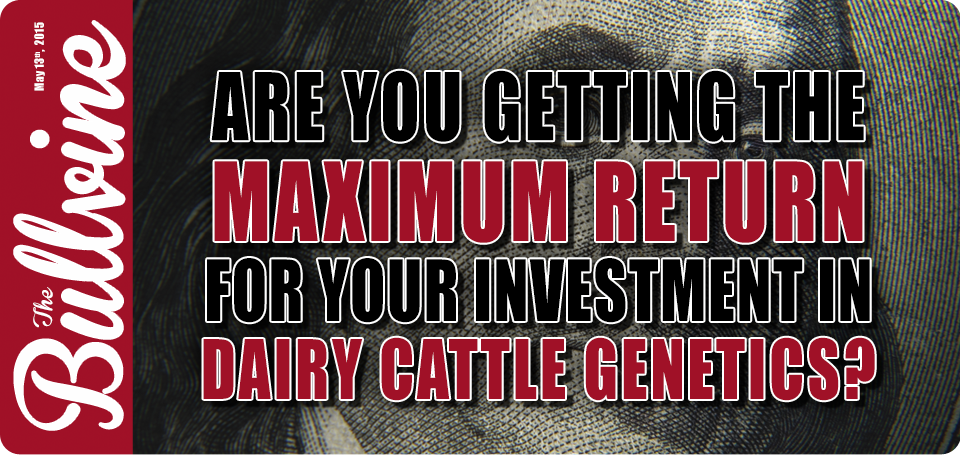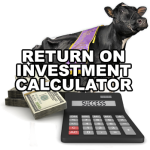It is a fact that dairy farmers do not need to own animals of documented and high genetic merit in order to produce milk. Many very successful milk producers use sires of more than one crossbreed to rotationally cross their herds. Purebred breeders planning to be profitable in the future should have a clear plan for how they intend investments in high genetic merit animals (aka purebreds) to augment the revenue from their farm.
Go Big or Go Home
The Bullvine has published articles on how to invest wisely in dairy genetics. Bruce Jobson’s article Roybrook Revisited on the famous Roybrook Herd contains Roy Ormston’s thought that “all breeders need to invest in the highest quality seed stock they can afford and life is too short to start with poor stock”. Andrew Hunt’s article “6 Ways to Invest $50,000 in Dairy Cattle Genetics” identifies that the best return on investment (+47%) comes when you invest $20,000 to $25,000 in the two best high genomic heifers you can find from top families. His second best (+38%) is the purchase of the very best, high genetically ranked, two-year-old. ALL other alternatives will yield a negative ROI. In purely financial terms, you get more for your money by investing only in the best.
The $10,000 Question
Pennsylvania dairyman John Kiser got the idea to poll dairy breeders on what how they would invest $10,000 in breeding stock. He posted the following question to the over 3,000 members on The Milk House discussion group.
You have $10,000 to invest in cattle/embryos or semen. Which would you choose?
- Buy 50 embryos from genomic heifers” (basically high production commercial cattle)
- Buy 20 embryos from an Excellent cow to make show calves
- Buy 1,000 straws of semen from various bulls hoping to cash in later (like the folks selling Goldwyn semen)
- Buy one young foundation type of cow
Although John called it a hypothetical question, actually it is very relevant. It covers the choices that every breeder faces when investing to improve the genetics in their herd.
The Top 4 Investment Choices
Here is a summary of the first fifty-two responses to John’s $10,000 question:
- Embryos from genomic heifers (15%)
- Twenty embryos to make show calves (39%)
- Invest in 1000 straws hoping to cash in later (10%)
- Buy one foundation cow (36%)
- (10 responses selected an option other than those offered)
Clearly the majority of respondents from the Milk House survey are not thinking along the same lines as Master Breeder Roybrook and The Bullvine’s recommendations when it comes to getting returns from their investment in genetics. They fall more in line with another Bullvine article “Master Breeders are not Home Run Hitter’.
Fantastic Opportunity? Or Waste of Money? How do you spend genetic investment dollars?
Although all dairy operations expect a return on investment, when it comes to genetics, the $10,000 question produced a variety of answers in targeting that goal. It is important to weigh the options in terms of success rate. We will look at them ranked on popular choice and then consider the financial implications.
Buy 1000 straws of various bulls hoping to cash in later: Many respondents mentioned that with the quick turnover of bulls these days this practice no longer made business sense. One person suggested that ‘elite young sires start out at $100+ and likely with only one in fifty, at best, possibly being in demand in 3-5 years this was sure fire way to have a significant negative ROI.
Embryos from Genomic Heifers: Many commented that they, as yet, did not have enough confidence on genomics to go that route. Although many that did not select this option did say it may well be the best choice for the future. No respondents mentioned it, but investing in embryos from multiple heifers spreads the risk and gives the best opportunity to get a high outlier. Some did mention that $200 per embryo seemed low for unsexed embryos from top heifers, but they recognized that bargains could be had. After all, 2400 to 2500 gTPI heifers can produce 2700+ gTPI calves when mated to elite sires.
Buy a young foundation type of cow: A popular choice for respondents, this option left open to respondent’s interpretation what a foundation cow is. Assuming that would mean a cow with pedigree, production, classification, cow family and genetic appeal it is a practice many breeders may be most comfortable with when it comes to building the genetic level in their herd. It also has the limiting factor, as some respondents mentioned, of having only one cow and cow family for the herd. As far as ROI, The Bullvines calculations, referred to previously, show an ROI of -77% for this option.
Embryos from an Excellent cow to produce Show Calves: The fact that this was the most popular choice identified that the majority of group members responding were thinking in traditional terms of breeding and generating revenue. None mentioned that only the very best show calves now command the top dollars and that many showy calves from Excellent dams sell in sales for under $3,000. Remember it cost $2,500 to get a heifer to milking age. For what is happening to sale prices consider reading An Insider’s Guide to What Sells at the Big Dairy Cattle Auctions and An Insider’s Guide to What Sells at the Big Dairy Cattle Auctions 2013. Another fact mentioned by one respondent was the fact that putting all your eggs in one basket (one Excellent cow) may not be the wisest decision.
Other Options: 20% of respondents mentioned that they would use the $10,000 differently with the majority preferring to purchase two high genomically indexing heifers that have the indexes and are sound for conformation but they could be the least fancy heifer of a flush. And yes a couple of respondents mentioned using the dollars elsewhere including for other farm improvements or farm family purposes.
Keys to Genetic ROI Success
Success is not something that is automatic when it comes to breeding a top individual animal or an entire herd. Where once breeders determined their success in terms of a single individual animal, success has now moved to where it is not only about animals but also about business success (ROI).
Some keys to being successful in the future are likely to include:
- Be prepared for the industry to change as much in the next five years as it has in the past twenty years. The demand for genetics will be focused on the top 1 to 5%.
- Have a documented plan covering genetics, marketing and finances as measured by profit. (Read more: What’s the plan?, Flukes and Pukes – What Happens When You Don’t Have a Plan)
- Your plan needs to be dynamic, fit your farm, include the continual incorporation of new technology and contain a chapter on human resources to achieve the plan.
- A business plan for genetic ROI success also includes using opportunity, consideration of risk and keeping costs under control.
The Bullvine Bottom Line
The sale of genetics from your herd in the next few years will change if it has not already done so. It will be about selling superior not average genetics. Investing for your future returns from genetics needs to be all about business.
Not sure how much to spend on that great 2 year old or heifer?
Want to make sure you are investing your money wisely?
Download our Dairy Cow Investment Calculator.


















Leave a Reply
You must be logged in to post a comment.